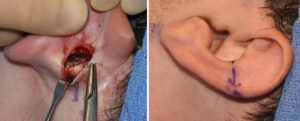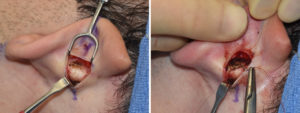Otoplasty is the generic term for many differ types of aesthetic ear surgeries. The term is most commonly associated with the setback procedure or ear pinning. This is where the ears stick out or protrude too far from the side of the head and the ear cartilage is reshaped or repositioned to bring the ear closure to the side of the head. (decreased auriculocephalic angle) This is done through an incision on the back of the ear which may or may not involve some postauricular skin removal.
In the traditional sense an otoplasty exposes much of the cartilage on the back of the ear to perform the procedure. This becomes necessary to adequately reshape the ear in most cases. An alternative non-open or closed otoplasty procedure has been described and used to theoretically create the same effect as an open procedure to lessen the scar burden. But it is technically harder to perform and has less consistent results.

One advantage of a more limited procedure is that the need for any postauricular skin removal is not necessary. That has no benefit for either improving exposure or adding to what the reshaping sutures are doing. This is in contrast to what is often done in the more complete traditional otoplasty.
Dr. Barry Eppley
Indianapolis, Indiana




